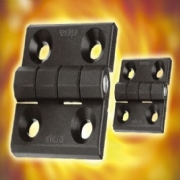 Add My Company
Add My Company
Sign In

There are a wide range of plastic hinges on the market and often it is necessary to put a significant weight of equipment on even small doors, therefore the following notes are offered as a guide to choosing a convenient type and the correct number of hinges appropriate to the door being hinged. Technical designers should consider the values Er, Ea, E90 tabulated in the data sheet of every Elesa plastic hinge. Maximum working load (Er, Ea, E90) is the value at which elastic deformation remains neglectable during functioning. Load at breakage (Rr, Ra, R90) should be used for safety verification, if required.
In case of use of CFN. and CFO. hinges, because of the geometry and the structure of these components, E90 value is not relevant. So the calculations shown, where E90 appears, are not valid for those hinges.
Hinged door on a vertical axis
These are the three conditions to be verified:
[(PxD1) + (P1xD2)] / D3 ≤ Er with closed door
(P+P1) / N ≤ Ea
[(PxD1) + (P1xD2)] / D3 ≤ E90 with 90° open door (*)
Hinged door on a horizontal axis
These are the two conditions to be verified:
(P+P1) / N≤Er with closed door
(P+P1) / 2N≤E90 with 90° open door (*) (in the case of balanced additional extra load on the door)
(*) Not valid for CFN. and CFO. series
Suggestions for drilling fitting holes
The proper application of hinges with moulded-in studs or bushings requires a drilling on the mounting wall with diameter not wider than 0.5mm of the major diameter of the assembling screw in order to guarantee an adequate shoulder of the metal insert on the wall itself.
Notes
All the values reported in the tables are the result of tests carried out in our laboratories under controlled temperature and humidity (23°C – 50% RH) in given conditions of use and for a relatively limited time. The technical designer should consider using an adequate safety factor for particularly heavy conditions of use.
Example
P
=
10 Kg = 98 N (10x9.81) weight of the door
P1
=
5 Kg = 49 N (5x9.81) weight of the additional extra load
N
=
2 (start evaluating two hinges)
W
=
1.6m width of the door
D1
=
W/2 = 1.6/2 = 0.8m distance between the centre of gravity of the door and the hinge axis.
D2
=
1.2m distance between the hinge axis and additional extra load application point
D3
=
1.8m (the example shows only the distance between the two assembled hinges)
[(PxD1) + (P1xD2)] / D3 ≤ Er with closed door
[(98x0.8) + (49x1.2)] / 1.8 = 76 N ≤ Er
(P+P1) / N ≤ Ea
(98 + 49) / 2 = 73.5 N ≤ Ea
[(PxD1) + (P1xD2)] / D3 ≤ E90 with 90° open door
[(98x0.8) + (49x1.2)] / 1.8 = 76 N ≤ E90 (*)
(*) Not valid for CFN. and CFO. series.
Considering for example CFD. series, the right dimension can be chosen amongst the hinges with Er, Ea and E90 values exceeding the values calculated, that are CFD.40 B-M4, CFD.40 CH-4-B-M4, CFD.4-p-M4x18 or any CFD.48 and CFD.66.
For more information on Guidelines for the application of plastic hinges talk to Elesa (UK) Ltd
Enquire Now
List your company on FindTheNeedle.

